The euro area bank lending survey - Third quarter of 2024
In the October 2024 bank lending survey (BLS), euro area banks reported unchanged credit standards for loans or credit lines to enterprises in the third quarter of 2024 (net percentage of banks of 0%; see Overview table).[1] This follows more than two years of successive tightening. While credit standards remained unchanged in net terms, risk perceptions were still reported as having a small tightening impact. A further tightening of credit standards was reported only in two small countries, while a small net easing was reported in Germany. The net percentage of banks was lower than in the previous quarter (3%) and than expected in the previous survey round (5%). Banks expect a renewed, albeit moderate, net tightening for the fourth quarter of 2024 (4%).
Banks reported a further net easing of credit standards for loans to households for house purchase, whereas a further net tightening was reported for consumer credit (net percentages of -3% and 6%; see Overview table). For housing loans, competition from other banks and banks’ cost of funds and balance sheet situation were the main drivers behind the net easing of credit standards, reported mostly by banks in France. By contrast, a small tightening impact came from risk perceptions and “other factors”, the latter related to tighter sustainability rules for residential real estate. The further net easing at the euro area level was driven solely by banks in France reporting a very strong easing; banks in Germany reported some net tightening and banks in all other euro area countries reported unchanged credit standards on housing loans. The net easing at the euro area level was somewhat more pronounced than banks had expected in the previous quarter (-1%). For credit standards on consumer credit, risk perceptions and banks’ risk tolerance were the main drivers of the net tightening. The tightening in credit standards for consumer credit was observed across the four largest euro area economies, exceeding the expectations by banks in the previous quarter (1%), and was around the historical average (5%). For the fourth quarter banks expect credit standards for housing loans to ease strongly (-12%), driven by banks in France, and credit standards for consumer credit to tighten slightly (3%).
Net demand for loans by firms increased moderately in the third quarter of 2024 (for the first time since the third quarter of 2022), while remaining weak overall (net percentage of 4%; see Overview table). The moderate increase in loan demand was reported as mainly driven by declining interest rates, with a muted contribution from fixed investment, after about two years of a negative impact from these factors. The aggregate picture masks substantial heterogeneity at the country level: while banks in Germany, Spain and France saw increases in loan demand, banks in Italy and eight of the other sixteen countries continued to report a net decrease in loan demand. For the fourth quarter banks expect loan demand to increase moderately further (4%).
Net demand for housing loans rebounded strongly, while consumer credit demand increased more moderately (net percentages of 39% and 8% respectively; see Overview table). The net increase in housing loan demand was mainly driven by the general level of interest rates and housing market prospects. This provides a further signal of recovery from the strong declines over the tightening cycle. The net increase was the highest since the second quarter of 2015 (42%), was above banks’ expectations in the previous quarter (26%) and broad based across euro area countries. It is directionally in line with the gradual strengthening of actual mortgage lending in July and August. Consumer credit demand was supported by improving consumer confidence and spending on durables. The net demand for consumer credit was also broadly in line with expectations (net increase of 7%). In the fourth quarter banks expect loans in both categories to increase further, more substantially so for housing loans (44%) than for consumer credit (11%).
Banks’ overall credit terms and conditions eased strongly for housing loans and slightly for loans to firms, but saw a moderate tightening for consumer credit. Lending rates and margins on average loans were the main drivers of the net easing of terms and conditions for housing loans and loans to firms. By contrast, margins on both riskier and average loans were the main drivers of tighter consumer credit terms and conditions.
Banks reported a broadly unchanged share of rejected applications for housing loans, a small increase in rejected loans to non-financial corporates and a moderate increase in rejected applications for consumer credit.
The October 2024 survey contained several ad hoc questions.
- The access to funding of euro area banks improved moderately for retail funding, money markets and debt securities in the third quarter of 2024. Access to short-term retail funding improved, whereas access to long-term retail funding remained broadly unchanged. Access to funding also improved for money markets and debt securities. Over the next three months banks expect access to funding to remain broadly unchanged across market segments.
- The reduction in the ECB’s monetary policy asset portfolio had a slightly negative impact on euro area banks’ market financing conditions over the last six months, which banks expect to continue over the next six months too. In addition, banks reported a contained overall impact from the reduction of the monetary policy asset portfolio on their lending conditions and volumes, except for housing loans, for which they registered a tightening impact on credit standards. Banks expect the contained overall tightening impact to persist in the coming six months, reflecting the ongoing gradual and predictable adjustment of the ECB’s monetary policy asset portfolio.
- The phase-out of TLTRO III continued to affect bank liquidity positions negatively. However, in light of the comparatively small remaining outstanding amounts of TLTRO III, banks reported a broadly neutral impact on their overall funding conditions and neutral effects on lending conditions and loan volumes.
- Euro area banks reported the first negative impact of the ECB interest rate decisions on their net interest margins over the past six months since the end of 2022, while the impact via volumes of interest-bearing assets and liabilities remained negative. Although banks expect rate policy to contribute to an increase in intermediation volumes associated with rate decisions, supporting profitability in the coming six months, the negative net impact on margins associated with the ECB rate policy is expected to deepen and result in a decline in overall profitability from the high levels reached during the 2022-2023 tightening cycle. Banks expect the impact of provisions and impairments on profitability to remain slightly negative.
Overview table
Latest BLS results for the largest euro area countries
(net percentages of banks reporting a tightening of credit standards or an increase in loan demand)
Country |
Enterprises |
House purchase |
Consumer credit |
|||||||||||||||
|---|---|---|---|---|---|---|---|---|---|---|---|---|---|---|---|---|---|---|
Credit standards |
Demand |
Credit standards |
Demand |
Credit standards |
Demand |
|||||||||||||
Q2 24 |
Q3 24 |
Avg |
Q2 24 |
Q3 24 |
Avg |
Q2 24 |
Q3 24 |
Avg |
Q2 24 |
Q3 24 |
Avg |
Q2 24 |
Q3 24 |
Avg |
Q2 24 |
Q3 24 |
Avg |
|
Euro area |
3 |
0 |
9 |
-7 |
4 |
-2 |
-6 |
-3 |
6 |
16 |
39 |
0 |
6 |
6 |
5 |
13 |
8 |
0 |
Germany |
3 |
-3 |
4 |
16 |
13 |
5 |
7 |
7 |
4 |
30 |
44 |
6 |
7 |
15 |
1 |
14 |
26 |
6 |
Spain |
0 |
0 |
9 |
8 |
17 |
-6 |
10 |
0 |
14 |
20 |
10 |
-10 |
17 |
8 |
11 |
33 |
17 |
-7 |
France |
8 |
0 |
7 |
-17 |
8 |
-5 |
-33 |
-22 |
3 |
0 |
67 |
1 |
0 |
8 |
0 |
8 |
-15 |
-2 |
Italy |
-9 |
0 |
11 |
-36 |
-9 |
3 |
-9 |
0 |
1 |
27 |
45 |
8 |
8 |
8 |
5 |
0 |
8 |
9 |
Notes: “Avg” refers to historical averages, which are calculated over the period since the beginning of the survey, excluding the most recent round. Owing to the different sample sizes across countries, which broadly reflect the differences in the national shares in lending to the euro area non-financial private sector, the size and volatility of the net percentages cannot be directly compared across countries.
Box 1
General notes
The BLS is addressed to senior loan officers at a representative sample of euro area banks, representing all euro area countries and reflecting the characteristics of their respective national banking structures. The main purpose of the BLS is to enhance the Eurosystem’s knowledge of bank lending conditions in the euro area.[2]
Detailed tables and charts based on the responses provided can be found in Annex 1 for the standard questions and Annex 2 for the ad hoc questions. In addition, BLS time series data are available on the ECB’s website via the ECB Data Portal.
Detailed explanations on the BLS questionnaire, the aggregation of banks’ replies to national and euro area BLS results, the BLS indicators and information on the BLS series keys are available on the ECB’s website in the BLS user guide. A copy of the BLS questionnaire and a glossary of BLS terms can also be found on the ECB's website.
2.1 Credit standards remained unchanged
Euro area banks reported unchanged credit standards for loans or credit lines to enterprises in the third quarter of 2024 (net percentage of banks of 0%; see Chart 1 and Overview table).[3] This follows more than two years of successive tightening. A further tightening of credit standards was reported only in two small countries, while a small net easing was reported in Germany. Compared with historical averages, the net percentage was lower than both the average since 2003 (9%) and the average since 2014 (3%).[4] The net percentage was also lower than expected in the previous survey round (5%). Credit standards for loans to small and medium-sized enterprises (SMEs) and loans to large firms remained unchanged (net percentages of 0% for each; see Chart 2). Across maturities, banks reported broadly unchanged credit standards for short-term loans (1%), and a very small tightening for long-term loans (2%).
Banks’ risk perceptions related to the economic outlook and firm-specific situations were still reported to have a small tightening impact (see Chart 1 and Table 1). Banks’ cost of funds and balance sheet constraints, their risk tolerance and competition had a broadly neutral impact, similar to previous quarters. Among the largest euro area countries, risk perceptions were reported as a tightening factor in Germany, while banks’ risk tolerance was reported as having an easing impact in Spain.
Chart 1
Changes in credit standards applied to the approval of loans or credit lines to enterprises, and contributing factors
(net percentages of banks reporting a tightening of credit standards and contributing factors)
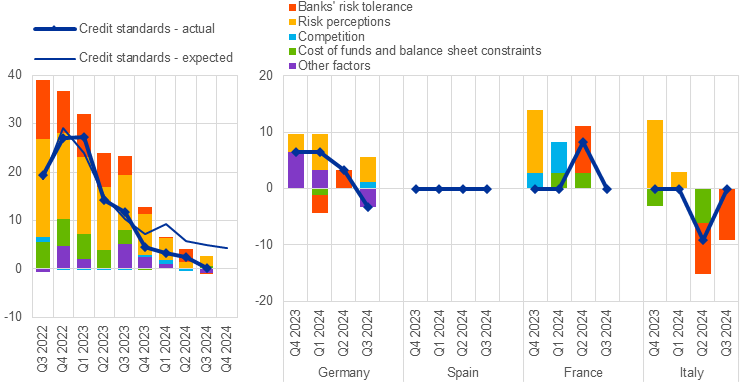
Notes: “Actual” values are changes that have occurred, while “expected” values are changes anticipated by banks. Net percentages are defined as the difference between the sum of the percentages of banks responding “tightened considerably” and “tightened somewhat” and the sum of the percentages of banks responding “eased somewhat” and “eased considerably”. “Cost of funds and balance sheet constraints” is the unweighted average of “banks’ capital and the costs related to banks’ capital position”, “access to market financing” and “liquidity position”; “Risk perceptions” is the unweighted average of “general economic situation and outlook”, “industry or firm-specific situation and outlook/borrower’s creditworthiness” and “risk related to the collateral demanded”; and “Competition” is the unweighted average of “competition from other banks”, “competition from non-banks” and “competition from market financing”. The net percentages for “Other factors” refer to an average of the further factors which were mentioned by banks as having contributed to changes in credit standards.
Chart 2
Changes in credit standards applied to the approval of loans or credit lines to SMEs and large enterprises, and contributing factors
(net percentages of banks reporting a tightening of credit standards and contributing factors)
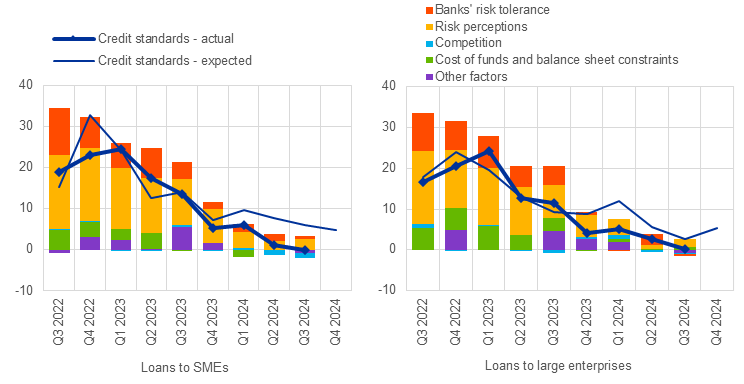
Note: See the notes to Chart 1.
In the fourth quarter of 2024 euro area banks expect a moderate net tightening for loans to firms (net percentage of 4%). They expect a similar degree of net tightening for loans to SMEs and loans to large firms, as well as for short-term and long-term loans.
Table 1
Factors contributing to changes in credit standards for loans or credit lines to enterprises
(net percentages of banks)
Country |
Cost of funds and balance sheet constraints |
Pressure from competition |
Perception of risk |
Banks’ risk tolerance |
||||
|---|---|---|---|---|---|---|---|---|
Q2 2024 |
Q3 2024 |
Q2 2024 |
Q3 2024 |
Q2 2024 |
Q3 2024 |
Q2 2024 |
Q3 2024 |
|
Euro area |
0 |
1 |
0 |
0 |
1 |
2 |
3 |
0 |
Germany |
0 |
0 |
0 |
1 |
0 |
4 |
3 |
0 |
Spain |
0 |
0 |
0 |
0 |
0 |
0 |
0 |
0 |
France |
3 |
0 |
0 |
0 |
0 |
0 |
8 |
0 |
Italy |
-6 |
0 |
0 |
0 |
0 |
0 |
-9 |
-9 |
Note: See the notes to Chart 1.
2.2 Terms and conditions eased slightly
Banks’ overall terms and conditions for new loans to enterprises eased slightly (net percentage of -2%; see Chart 3 and Table 2).[5] This was driven by lower margins on average loans (defined as the spread over relevant market reference rates) and lower lending rates on new loans, while margins on riskier loans and collateral requirements increased slightly. Other terms and conditions had a neutral impact. Across the four largest economies, German and French banks reported unchanged terms and conditions, while these eased in Spain and Italy. An easing impact of lower lending rates and compressed margins on average loans were reported by banks across all four of the largest euro area countries. Overall terms and conditions eased to a similar extent for loans to SMEs as for loans to large firms (net percentages of -4% and -5% respectively; see Chart 4). In both segments of corporate loans, the net easing was driven primarily by lending rates and margins on average loans.
Chart 3
Changes in terms and conditions on loans or credit lines to enterprises
(net percentages of banks reporting a tightening of terms and conditions)
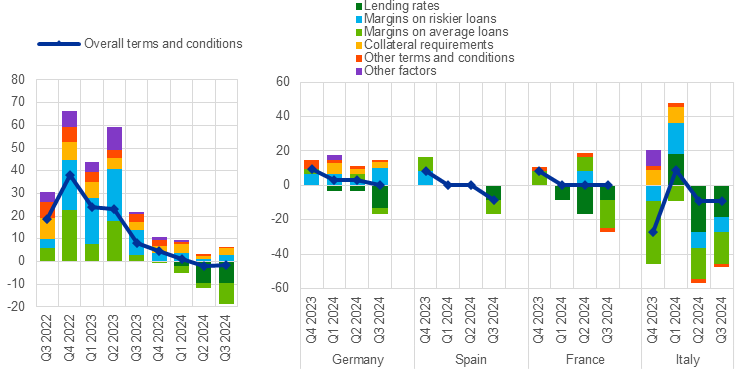
Notes: “Lending rates” was introduced in April 2024. “Margins” are defined as the spread over relevant market reference rates. “Other terms and conditions” is the unweighted average of “non-interest rate charges”, “size of the loan or credit line”, “loan covenants” and “maturity”. The net percentages for “Other factors” refer to an average of the further factors which were mentioned by banks as having contributed to changes in terms and conditions.
Competition was the main factor behind the easing of terms and conditions, while banks’ risk perceptions had a small tightening impact (see Table 3). The net easing impact of competition was mainly related to competition with other banks (net percentage of -6%), especially in France and Italy. Risk perceptions had a net tightening impact especially in Germany. Cost of funds and balance sheet conditions had a neutral impact, as did banks’ risk tolerance.
Table 2
Changes in terms and conditions on loans or credit lines to enterprises
(net percentages of banks)
Country |
Overall terms and conditions |
Banks’ lending rates |
Banks’ margins on average loans |
Banks’ margins on riskier loans |
||||
|---|---|---|---|---|---|---|---|---|
Q2 2024 |
Q3 2024 |
Q2 2024 |
Q3 2024 |
Q2 2024 |
Q3 2024 |
Q2 2024 |
Q3 2024 |
|
Euro area |
-2 |
-2 |
-10 |
-10 |
-2 |
-9 |
1 |
3 |
Germany |
3 |
0 |
-3 |
-13 |
3 |
-3 |
3 |
10 |
Spain |
0 |
-8 |
0 |
-8 |
0 |
-8 |
0 |
0 |
France |
0 |
0 |
-17 |
-8 |
8 |
-17 |
8 |
0 |
Italy |
-9 |
-9 |
-27 |
-18 |
-18 |
-18 |
-9 |
-9 |
Note: See the notes to Chart 3.
Chart 4
Changes in terms and conditions on loans or credit lines to SMEs and large enterprises
(net percentages of banks reporting a tightening of terms and conditions)
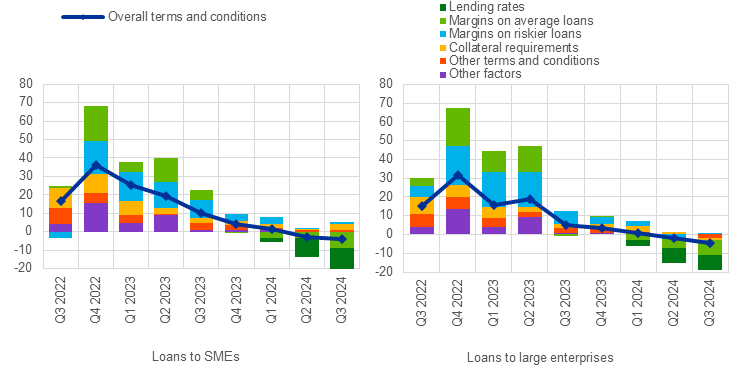
Note: See the notes to Chart 3.
Table 3
Factors contributing to changes in overall terms and conditions on loans or credit lines to enterprises
(net percentages of banks)
Country |
Cost of funds and balance sheet constraints |
Pressure from competition |
Perception of risk |
Banks’ risk tolerance |
|||||
|---|---|---|---|---|---|---|---|---|---|
Q2 2024 |
Q3 2024 |
Q2 2024 |
Q3 2024 |
Q2 2024 |
Q3 2024 |
Q2 2024 |
Q3 2024 |
||
Euro area |
0 |
0 |
-5 |
-2 |
6 |
2 |
1 |
0 |
|
Germany |
1 |
2 |
0 |
-1 |
3 |
8 |
0 |
0 |
|
Spain |
-3 |
-6 |
0 |
0 |
0 |
0 |
0 |
0 |
|
France |
3 |
-3 |
-8 |
-3 |
11 |
0 |
0 |
0 |
|
Italy |
0 |
0 |
-9 |
-3 |
6 |
-3 |
0 |
-9 |
|
Notes: The net percentages for these questions relating to contributing factors are defined as the difference between the percentage of banks reporting that the given factor contributed to a tightening and the percentage of banks reporting that it contributed to an easing. “Cost of funds and balance sheet constraints” is the unweighted average of “banks’ capital and the costs related to banks’ capital position”, “access to market financing” and “liquidity position”; “Risk perceptions” is the unweighted average of “general economic situation and outlook”, “industry or firm-specific situation and outlook/borrower’s creditworthiness” and “risk related to the collateral demanded”; and “Competition” is the unweighted average of “competition from other banks”, “competition from non-banks” and “competition from market financing”.
2.3 Rejection rates continued to increase
Banks reported a further net increase in the share of rejected loan applications for firms (net percentage of 2%; see Chart 5). The net increase was larger for loans to SMEs (net percentage of 7%) than for loans to large firms (3%). The further increase in the share of rejected loan applications was mainly driven by developments in Germany. By contrast, Spanish and French banks reported an unchanged share, while Italian banks reported a decrease.
Chart 5
Changes in the share of rejected loan applications for enterprises
(net percentages of banks reporting an increase)
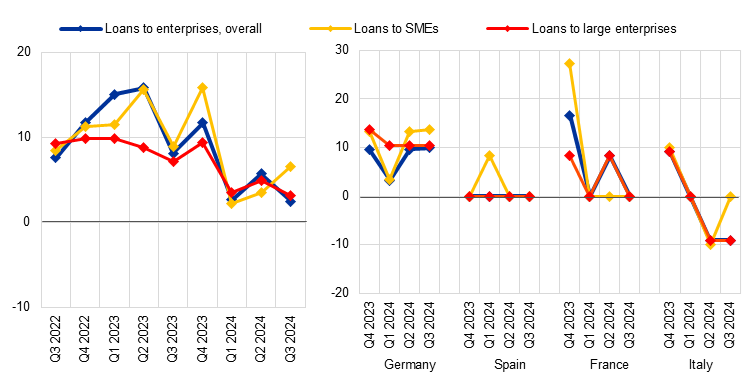
Notes: Share of rejected loan applications relative to the volume of all loan applications in that loan category. The breakdown by firm sizes was introduced in the first quarter of 2022.
2.4 Net demand for loans increased moderately
Firms’ net demand for loans increased moderately in the third quarter of 2024 (net percentage of 4%; see Chart 6), for the first time since the third quarter of 2022.[6] The aggregate picture masks substantial heterogeneity at the country level: while banks in Germany, Spain and France saw loan demand increases, banks in Italy and eight of the other sixteen countries continued to report a net decrease. The increase was more muted than banks had expected in the previous quarter (net percentage of 10%) and was reported as driven by SMEs (net percentage of 3%, see Chart 7), with unchanged loan demand from large firms (net percentage of 0%).
Chart 6
Changes in demand for loans or credit lines to enterprises, and contributing factors
(net percentages of banks reporting an increase in demand, and contributing factors)
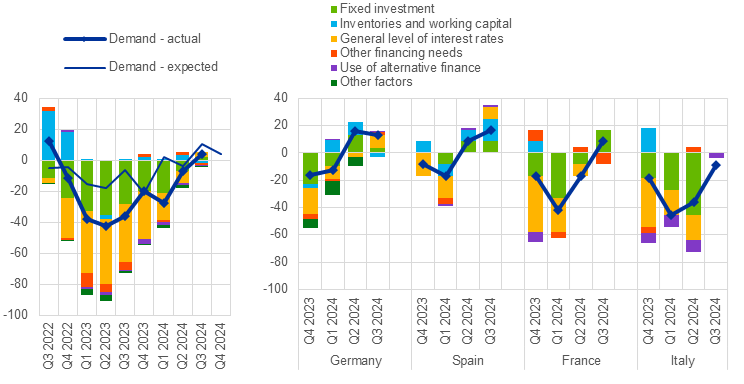
Notes: “Actual” values are changes that have occurred, while “expected” values are changes anticipated by banks. Net percentages for the questions on demand for loans are defined as the difference between the sum of the percentages of banks responding “increased considerably” and “increased somewhat” and the sum of the percentages of banks responding “decreased somewhat” and “decreased considerably”. “Other financing needs” is the unweighted average of “mergers/acquisitions and corporate restructuring” and “debt refinancing/restructuring and renegotiation”; and “Use of alternative finance” is the unweighted average of “internal financing”, “loans from other banks”, “loans from non-banks”, “issuance/redemption of debt securities” and “issuance/redemption of equity”. The net percentages for “Other factors” refer to an average of the further factors which were mentioned by banks as having contributed to changes in loan demand.
Chart 7
Changes in demand for loans or credit lines to SMEs and large enterprises, and contributing factors
(net percentages of banks reporting an increase in demand, and contributing factors)
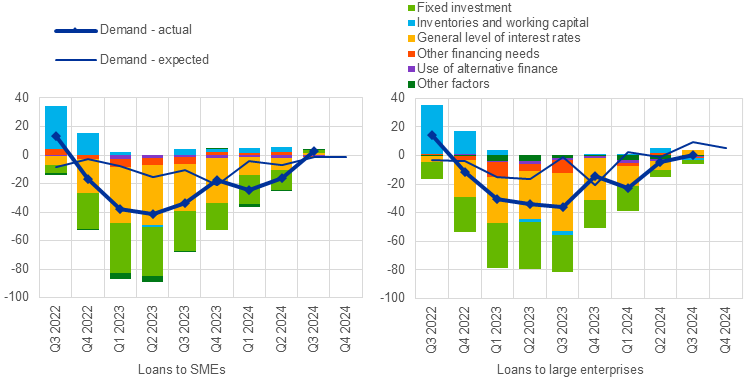
The net increase in loan demand was mainly driven by declining interest rates, with a muted contribution from fixed investment, after broadly two years of a negative impact from these factors (see Chart 6 and Table 4). The general level of interest rates was reported by banks in Germany and Spain as contributing to higher loan demand, and also no longer had a negative impact on demand in France and Italy. The level of rates was primarily reported as having increased demand by large enterprises (see Chart 7). The impact of fixed investment on loan demand was slightly asymmetric between SMEs (net percentage of 2% reporting an increase) and large enterprises (-3%).
Table 4
Factors contributing to changes in demand for loans or credit lines to enterprises
(net percentages of banks)
Country |
Fixed investment |
Inventories and working capital |
Other financing needs |
General level of interest rates |
Use of alternative finance |
|||||
|---|---|---|---|---|---|---|---|---|---|---|
Q2 2024 |
Q3 2024 |
Q2 2024 |
Q3 2024 |
Q2 2024 |
Q3 2024 |
Q2 2024 |
Q3 2024 |
Q2 2024 |
Q3 2024 |
|
Euro area |
-7 |
2 |
4 |
-2 |
2 |
-1 |
-8 |
3 |
-2 |
-1 |
Germany |
13 |
3 |
10 |
-3 |
0 |
2 |
-3 |
10 |
0 |
1 |
Spain |
8 |
8 |
8 |
17 |
0 |
0 |
0 |
8 |
2 |
2 |
France |
-8 |
17 |
0 |
0 |
4 |
-8 |
-8 |
0 |
0 |
0 |
Italy |
-45 |
0 |
0 |
0 |
5 |
0 |
-18 |
0 |
-9 |
-4 |
Note: See the notes to Chart 6.
Banks expect a net increase in demand for loans to firms for the fourth quarter of 2024 (net percentage of 4%). They expect loan demand to increase for large enterprises (5%) but remain broadly unchanged for SMEs (-1%).
3.1 Credit standards eased further
Euro area banks reported a further net easing of credit standards on loans to households for house purchase (net percentage of banks of -3%; see Chart 8 and Overview table). This is the third consecutive net easing after credit standards tightened throughout 2022 and 2023. The net easing was somewhat more pronounced than banks had expected in the previous quarter (-1%), and net percentages remained below the historical averages.[7] At the euro area level this was driven solely by banks in France reporting a very strong easing; banks in Germany reported some net tightening, and banks in all other euro area countries reported unchanged credit standards on housing loans.
Chart 8
Changes in credit standards applied to the approval of loans to households for house purchase, and contributing factors
(net percentages of banks reporting a tightening of credit standards, and contributing factors)

Notes: “Actual” values are changes that have occurred, while “expected” values are changes anticipated by banks. Net percentages are defined as the difference between the sum of the percentages of banks responding “tightened considerably” and “tightened somewhat” and the sum of the percentages of banks responding “eased somewhat” and “eased considerably”.. “Cost of funds and balance sheet constraints” is the unweighted average of “banks’ capital and the costs related to banks’ capital position”, “access to market financing” and “liquidity position”; “Risk perceptions” is the unweighted average of “general economic situation and outlook”, “housing market prospects, including expected house price developments” and “borrower’s creditworthiness”; and “Competition” is the unweighted average of “competition from other banks” and “competition from non-banks”. The net percentages for “Other factors” refer to an average of the further factors which were mentioned by banks as having contributed to changes in credit standards.
Competition from other banks and banks’ cost of funds and balance sheet situation were the main easing factors for credit standards on housing loans (see Chart 8 and Table 5). The net easing impact of these factors was mainly driven by banks in France. For competition from other banks, French banks reported the aim of increasing their market share for housing loans in a highly competitive market as a way of cross-selling other products such as insurance products. Competition from other banks had also a small net easing impact in Germany. Banks’ cost of funds and balance sheet situation, related to their liquidity position, had also a net easing impact, driven by banks in France; banks’ risk perceptions and risk tolerance had a broadly neutral impact at the euro area level. Among “other factors”, some banks referred to stricter sustainability rules for residential real estate, mainly related to the energy performance of buildings, as having a small net tightening impact on credit standards for housing loans.[8]
In the fourth quarter of 2024 euro area banks expect credit standards on housing loans to ease strongly (net percentage of -12%). If realised, this would be one of the strongest net easings on record. Across the four largest euro area economies, banks in France and, to a lesser extent, Italy expect an easing, whereas German and Spanish banks expect no change.
Table 5
Factors contributing to changes in credit standards for loans to households for house purchase
(net percentages of banks)
Country |
Cost of funds and balance sheet constraints |
Pressure from competition |
Perception of risk |
Banks’ risk tolerance |
||||
|---|---|---|---|---|---|---|---|---|
Q2 2024 |
Q3 2024 |
Q2 2024 |
Q3 2024 |
Q2 2024 |
Q3 2024 |
Q2 2024 |
Q3 2024 |
|
Euro area |
-2 |
-2 |
-9 |
-4 |
3 |
1 |
-1 |
0 |
Germany |
0 |
0 |
0 |
-2 |
1 |
4 |
0 |
-4 |
Spain |
0 |
0 |
0 |
0 |
0 |
0 |
10 |
0 |
France |
-7 |
-7 |
-33 |
-11 |
11 |
0 |
-11 |
0 |
Italy |
0 |
0 |
-5 |
0 |
0 |
0 |
0 |
0 |
Note: See the notes to Chart 8.
3.2 Terms and conditions eased strongly
Banks’ overall credit terms and conditions eased strongly for housing loans in the third quarter of 2024 (net percentage of -17%; see Chart 9 and Table 6). The net easing was mainly driven by a substantial contribution from lower lending rates and narrower margins on average loans. The net percentage for overall terms and conditions was the lowest since the start of the series in 2015.[9] This development was in line with moderate decreases in bank lending rates on mortgages since their peak in the fourth quarter of 2023. It was reported by banks in all four of the largest euro area countries. For margins on riskier loans, euro area banks reported only a small net easing, whereas collateral requirements and non-interest rate charges (within “other terms and conditions”) contributed to a small net tightening of terms and conditions.
Chart 9
Changes in terms and conditions on loans to households for house purchase
(net percentages of banks reporting a tightening of terms and conditions)
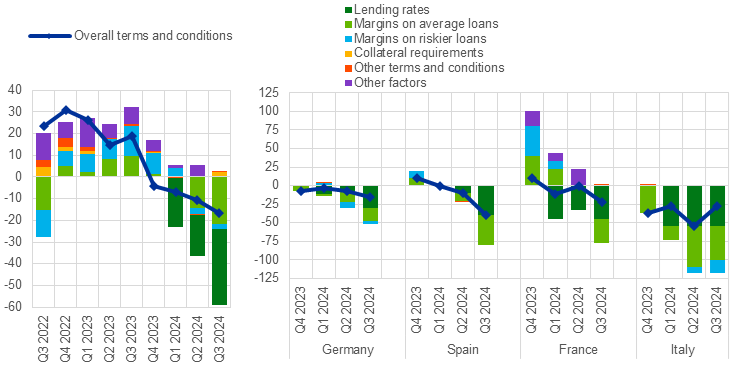
Notes: “Lending rates” was introduced in April 2024. “Margins” are defined as the spread over relevant market reference rates. “Other terms and conditions” is the unweighted average of “loan-to-value ratio”, “other loan size limits”, “non-interest rate charges” and “maturity”. The net percentages for “Other factors” refer to an average of the further factors which were mentioned by banks as having contributed to changes in terms and conditions.
Table 6
Changes in terms and conditions on loans to households for house purchase
(net percentages of banks)
Country |
Overall terms and conditions |
Banks’ lending rates |
Banks’ margins on average loans |
Banks’ margins on riskier loans |
||||
|---|---|---|---|---|---|---|---|---|
Q2 2024 |
Q3 2024 |
Q2 2024 |
Q3 2024 |
Q2 2024 |
Q3 2024 |
Q2 2024 |
Q3 2024 |
|
Euro area |
-11 |
-17 |
-19 |
-35 |
-14 |
-22 |
-3 |
-2 |
Germany |
-7 |
-15 |
-7 |
-30 |
-15 |
-19 |
-7 |
-4 |
Spain |
-10 |
-40 |
-10 |
-40 |
-10 |
-40 |
0 |
0 |
France |
0 |
-22 |
-33 |
-44 |
0 |
-33 |
0 |
0 |
Italy |
-55 |
-27 |
-55 |
-55 |
-55 |
-45 |
-9 |
-18 |
Note: See the notes to Chart 9.
Competition was the main driver of the net easing of overall terms and conditions (see Table 7). This impact was reported by banks in all four of the largest euro area countries. To a smaller extent, banks’ cost of funds and balance sheet situation also had an easing impact, related to their liquidity position and market financing conditions. By contrast, banks’ risk perceptions and risk tolerance had a broadly neutral impact.
Table 7
Factors contributing to changes in overall terms and conditions on loans to households for house purchase
(net percentages of banks)
Country |
Cost of funds and balance sheet constraints |
Pressure from competition |
Perception of risk |
Banks’ risk tolerance |
||||
|---|---|---|---|---|---|---|---|---|
Q2 2024 |
Q3 2024 |
Q2 2024 |
Q3 2024 |
Q2 2024 |
Q3 2024 |
Q2 2024 |
Q3 2024 |
|
Euro area |
-3 |
-4 |
-17 |
-22 |
0 |
-1 |
0 |
-1 |
Germany |
-1 |
-1 |
-7 |
-11 |
0 |
-4 |
0 |
-4 |
Spain |
0 |
-10 |
-10 |
-30 |
0 |
0 |
0 |
0 |
France |
-7 |
-7 |
-22 |
-44 |
0 |
0 |
0 |
0 |
Italy |
-3 |
-3 |
-55 |
-27 |
0 |
0 |
0 |
0 |
Notes: The net percentages for these questions relating to contributing factors are defined as the difference between the percentage of banks reporting that the given factor contributed to a tightening and the percentage of banks reporting that it contributed to an easing. “Cost of funds and balance sheet constraints” is the unweighted average of “banks’ capital and the costs related to banks’ capital position”, “access to market financing” and “liquidity position”.
3.3 Rejection rates remained broadly unchanged
Banks reported a broadly unchanged share of rejected applications for housing loans (net percentage of -1%; see Chart 10). This followed a moderate decrease in the previous quarter, after large cumulative net increases between the second quarter of 2022 and the first quarter of 2024. Among the four largest euro area economies, the share of housing loan rejections decreased in Germany, while it remained unchanged in Spain, France and Italy.
Chart 10
Changes in the share of rejected loan applications for households
(net percentages of banks reporting an increase)
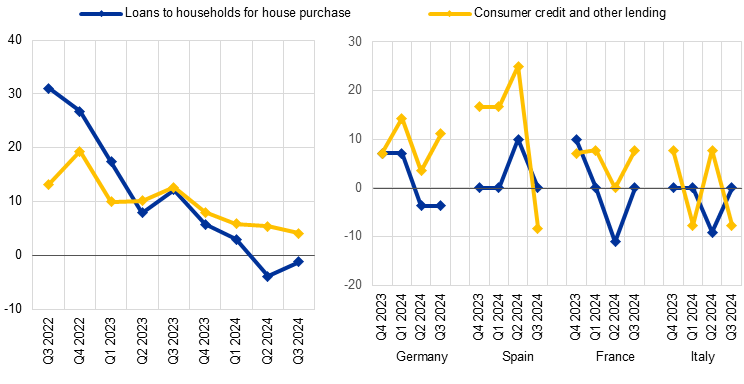
Note: Share of rejected loan applications relative to the volume of all loan applications in that loan category.
3.4 Net demand for loans increased strongly
Banks reported a strong net increase in the demand for housing loans (net percentage of 39%, see Chart 11 and Overview table).[10] Net demand for housing loans increased further and more strongly than in the previous quarter, providing a further signal of the start of a recovery from the strong declines over the monetary policy tightening cycle. This was the highest net percentage increase since the second quarter of 2015 (42%), was above banks’ expectations in the third quarter of 2024 (26%) and was broadly based across euro area countries. It is directionally in line with the gradual strengthening of actual mortgage lending in July and August. Banks in all four of the largest euro area economies and the majority of smaller countries reported a net increase in housing loan demand in the third quarter of 2024, with only banks in two small countries reporting a decrease.
Chart 11
Changes in demand for loans to households for house purchase, and contributing factors
(net percentages of banks reporting an increase in demand, and contributing factors)
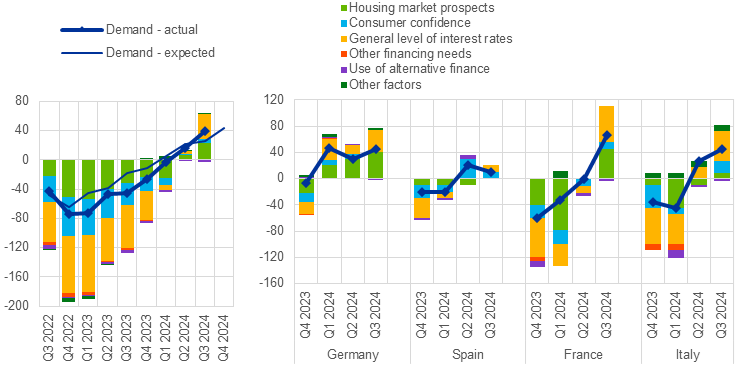
Notes: “Actual” values are changes that have occurred, while “expected” values are changes anticipated by banks. Net percentages for the questions on demand for loans are defined as the difference between the sum of the percentages of banks responding “increased considerably” and “increased somewhat” and the sum of the percentages of banks responding “decreased somewhat” and “decreased considerably”. “Other financing needs” is the unweighted average of “debt refinancing/restructuring and renegotiation” and “regulatory and fiscal regime of housing markets”; and “Use of alternative finance” is the unweighted average of “internal finance of house purchase out of savings/down payment”, “loans from other banks” and “other sources of external finance”. The net percentages for “Other factors” refer to an average of the further factors which were mentioned by banks as having contributed to changes in loan demand.
Declining interest rates and improving housing market prospects were the main factors having a positive impact on housing loan demand (see Chart 11 and Table 8). The positive impact of the decline in interest rates is broadly consistent with the moderation of euro area mortgage rates since the fourth quarter of 2023 and the further, albeit limited, rate decrease in July and August. A positive impact from the general level of interest rates was reported by banks across the four largest euro area countries. Banks also indicated that housing market prospects had a positive impact, consistent with a stabilisation of euro area residential property prices. They also referred to a positive impact from consumer confidence, albeit to a smaller extent. Banks in some countries referred to special lending programmes and marketing campaigns having had a positive impact on housing loan demand, which may be seen in connection with their reference to strong competition in this market segment.
In the fourth quarter of 2024 banks expect a further strong increase in housing loan demand (net percentage of banks of 44%). If realised, the net percentage for euro area banks would be similar to the historical peak of the series in the fourth quarter of 2005 (45%). Further recovery from the low levels reached in 2022 and 2023 is expected by banks in all four of the largest euro area economies.
Table 8
Factors contributing to changes in demand for loans to households for house purchase
(net percentages of banks)
Country |
Housing market prospects |
Consumer confidence |
Other financing needs |
General level of interest rates |
Use of alternative finance |
|||||
|---|---|---|---|---|---|---|---|---|---|---|
Q2 2024 |
Q3 2024 |
Q2 2024 |
Q3 2024 |
Q2 2024 |
Q3 2024 |
Q2 2024 |
Q3 2024 |
Q2 2024 |
Q3 2024 |
|
Euro area |
6 |
23 |
2 |
6 |
-1 |
0 |
3 |
34 |
-1 |
-2 |
Germany |
30 |
41 |
7 |
0 |
0 |
0 |
15 |
33 |
1 |
-1 |
Spain |
-10 |
0 |
30 |
10 |
0 |
0 |
0 |
10 |
7 |
0 |
France |
0 |
44 |
-11 |
11 |
0 |
0 |
-11 |
56 |
-4 |
-4 |
Italy |
-9 |
9 |
0 |
18 |
0 |
0 |
18 |
45 |
-3 |
-3 |
Note: See the notes to Chart 11.
4.1 Credit standards tightened moderately further
Banks reported a moderate further net tightening of credit standards on consumer credit and other lending to households (net percentage of 6%; see Chart 12 and Overview table). This followed a net tightening in the preceding quarter of the same size and exceeded banks’ expectations of broadly unchanged credit standards (1%). The net percentage was around the historical average of credit standards for consumer credit since 2003 (5%) and remained above the historical average since 2014 (3%).[11] The tightening in credit standards for consumer credit was observed across the four largest euro area economies.
Chart 12
Changes in credit standards applied to the approval of consumer credit and other lending to households, and contributing factors
(net percentages of banks reporting a tightening of credit standards, and contributing factors)
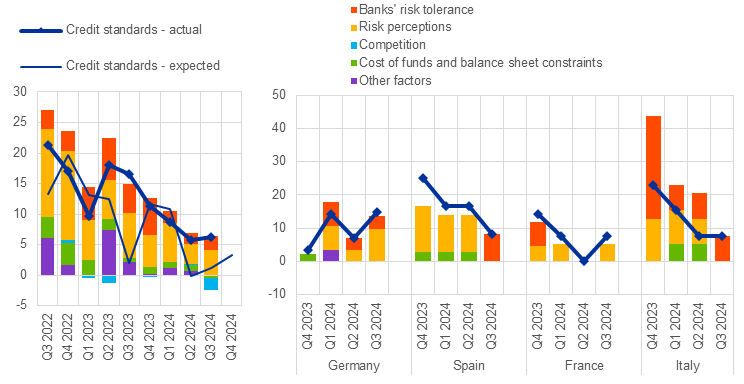
Notes: “Actual” values are changes that have occurred, while “expected” values are changes anticipated by banks. Net percentages are defined as the difference between the sum of the percentages of banks responding “tightened considerably” and “tightened somewhat” and the sum of the percentages of banks responding “eased somewhat” and “eased considerably”. “Cost of funds and balance sheet constraints” is the unweighted average of “banks’ capital and the costs related to banks’ capital position”, “access to market financing” and “liquidity position”; “Risk perceptions” is the unweighted average of “general economic situation and outlook”, “creditworthiness of consumers” and “risk on the collateral demanded”; and “Competition” is the unweighted average of “competition from other banks” and “competition from non-banks”. The detailed sub-factors under “Cost of funds and balance sheet constraints” were introduced in April 2024. The net percentages for “Other factors” refer to an average of the further factors which were mentioned by banks as having contributed to changes in credit standards.
Increased risk perceptions were the main driver of the net tightening of credit standards for consumer credit (see Chart 12 and Table 9). The increased risk perceptions, mostly related to the economic outlook and borrowers’ creditworthiness, are consistent with banks’ attentiveness to increases in credit risks for consumer credit, especially in Germany and France. Banks’ risk tolerance had a small tightening impact, while there was a small easing impact from competitive pressures.
In the fourth quarter of 2024 euro area banks expect credit standards for consumer credit and other lending to households to tighten slightly further (net percentage of 3%). Across the four largest economies the expected further tightening is driven by German and French banks, with Italian banks expecting unchanged credit standards and Spanish banks expecting easier credit standards.
Table 9
Factors contributing to changes in credit standards for consumer credit and other lending to households
(net percentages of banks)
Country |
Cost of funds and balance sheet constraints |
Pressure from competition |
Perception of risk |
Banks’ risk tolerance |
||||
|---|---|---|---|---|---|---|---|---|
Q2 2024 |
Q3 2024 |
Q2 2024 |
Q3 2024 |
Q2 2024 |
Q3 2024 |
Q2 2024 |
Q3 2024 |
|
Euro area |
1 |
0 |
0 |
-2 |
3 |
4 |
2 |
2 |
Germany |
0 |
0 |
0 |
0 |
4 |
10 |
4 |
4 |
Spain |
3 |
0 |
0 |
0 |
11 |
0 |
0 |
8 |
France |
0 |
0 |
0 |
0 |
0 |
5 |
0 |
0 |
Italy |
5 |
0 |
0 |
0 |
8 |
0 |
8 |
8 |
Note: See the notes to Chart 12.
4.2 Terms and conditions tightened moderately further
Banks’ overall terms and conditions applied when granting consumer credit and other lending to households tightened moderately further in net terms (net percentage of 4%, see Chart 13 and Table 10). The net percentage was marginally higher than in the previous quarter (3%).[12] Margins on both riskier and average loans were the main drivers of the tightening. Across the four largest economies, terms and conditions tightened in Germany, France and Italy, while they eased in Spain. French and Italian banks reported a tightening impact from lending rates, while German and Spanish banks saw the impact of lending rates to be on the easing side.
Perceptions of risk contributed most to the net tightening (see Table 11). Banks’ risk tolerance had a small additional tightening impact, while competitive pressure had a small easing impact. Banks’ cost of funds and balance sheet constraints had a broadly neutral impact. Banks’ risk perceptions contributed to the tightening in Germany and France, with German banks reporting also an increase in risk aversion. Competitive pressures had an easing impact in Spain and France.
Chart 13
Changes in terms and conditions on consumer credit and other lending to households
(net percentages of banks reporting a tightening of terms and conditions)
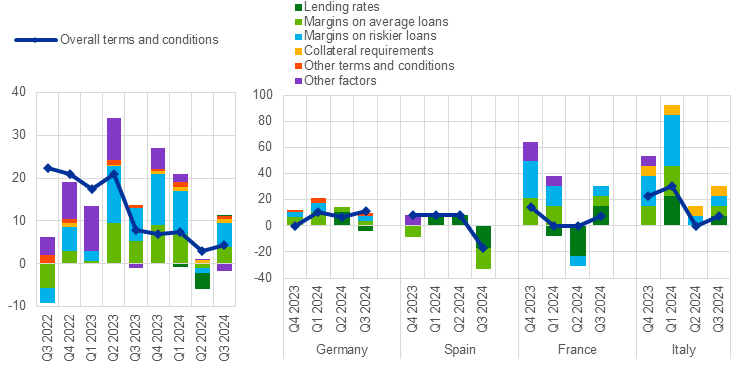
Notes: “Lending rates” was introduced in April 2024. “Margins” are defined as the spread over a relevant market reference rate. “Other terms and conditions” is the unweighted average of “size of the loan”, “non-interest rate charges” and “maturity”. The net percentages for “Other factors” refer to an average of the further factors which were mentioned by banks as having contributed to changes in terms and conditions.
Table 10
Changes in terms and conditions on consumer credit and other lending to households
(net percentages of banks)
Country |
Overall terms and conditions |
Banks’ lending rates |
Banks’ margins on average loans |
Banks’ margins on riskier loans |
||||
|---|---|---|---|---|---|---|---|---|
Q2 2024 |
Q3 2024 |
Q2 2024 |
Q3 2024 |
Q2 2024 |
Q3 2024 |
Q2 2024 |
Q3 2024 |
|
Euro area |
3 |
4 |
-4 |
0 |
-1 |
4 |
-1 |
6 |
Germany |
7 |
11 |
11 |
-4 |
4 |
4 |
0 |
4 |
Spain |
8 |
-17 |
8 |
-17 |
0 |
-17 |
0 |
0 |
France |
0 |
8 |
-23 |
15 |
0 |
8 |
-8 |
8 |
Italy |
0 |
8 |
0 |
8 |
0 |
8 |
8 |
8 |
Note: See the notes to Chart 13.
Table 11
Factors contributing to changes in overall terms and conditions on consumer credit and other lending to households
(net percentages of banks)
Country |
Cost of funds and balance sheet constraints |
Pressure from competition |
Perception of risk |
Banks’ risk tolerance |
||||
|---|---|---|---|---|---|---|---|---|
Q2 2024 |
Q3 2024 |
Q2 2024 |
Q3 2024 |
Q2 2024 |
Q3 2024 |
Q2 2024 |
Q3 2024 |
|
Euro area |
1 |
0 |
-2 |
-3 |
5 |
5 |
3 |
2 |
Germany |
4 |
2 |
-4 |
0 |
7 |
4 |
7 |
7 |
Spain |
3 |
-8 |
0 |
-8 |
0 |
0 |
0 |
0 |
France |
0 |
0 |
0 |
-8 |
8 |
15 |
0 |
0 |
Italy |
3 |
3 |
-8 |
0 |
8 |
0 |
8 |
0 |
Note: The net percentages for these questions relating to contributing factors are defined as the difference between the percentage of banks reporting that the given factor contributed to a tightening and the percentage of banks reporting that it contributed to an easing. “Cost of funds and balance sheet constraints” is the unweighted average of “banks’ capital and the costs related to banks’ capital position”, “access to market financing” and “liquidity position”.
4.3 Rejection rates increased further
Euro area banks reported a further moderate net increase in the share of rejected applications for consumer credit (4%; see Chart 10 above). While the net increase was the lowest since the first quarter of 2022, the increase adds to more than two years of consecutive increases, consistent with the further moderate net tightening of credit standards. The net increase was observed in two out of the four largest economies (Germany and France); Spanish and Italian banks reported a net decrease.
4.4 Net demand for loans increased
Banks reported increased demand for consumer credit and other lending to households (net percentage of banks at 8%, see Chart 14 and Overview table).[13] The increase in loan demand is broadly in line with banks’ expectations in the previous quarter (7%), albeit lower than the increase the previous quarter, and is broadly consistent with the developments in actual consumer credit volumes in July and August. The increase in loan demand was observed in Spain, Germany and Italy; there was a decrease in France.
The increase was primarily supported by improving consumer confidence (see Chart 14 and Table 12). Spending on durable goods and the decline in the general level of interest rates also contributed. Consumption expenditure financed through real estate-guaranteed loans and the use of alternative sources of finance, such as savings and loans from other banks, had a very small negative impact on loan demand.
Chart 14
Changes in demand for consumer credit and other lending to households, and contributing factors
(net percentages of banks reporting an increase in demand, and contributing factors)

Notes: “Actual” values are changes that have occurred, while “expected” values are changes anticipated by banks. Net percentages for the questions on demand for loans are defined as the difference between the sum of the percentages of banks responding “increased considerably” and “increased somewhat” and the sum of the percentages of banks responding “decreased somewhat” and “decreased considerably”. “Use of alternative finance” is the unweighted average of “internal financing out of savings”, “loans from other banks” and “other sources of external finance”. “Consumption exp. (real estate)” denotes “consumption expenditure financed through real estate-guaranteed loans”. The net percentages for “Other factors” refer to an average of the further factors which were mentioned by banks as having contributed to changes in loan demand.
In the fourth quarter of 2024 banks expect a net increase in demand for consumer credit and other lending to households (net percentage of 11%). Demand for consumer credit is expected to increase across the four largest economies.
Table 12
Factors contributing to changes in demand for consumer credit and other lending to households
(net percentages of banks)
Country |
Spending on durable goods |
Consumer confidence |
Consumption exp. (real estate) |
General level of interest rates |
Use of alternative finance |
|||||
|---|---|---|---|---|---|---|---|---|---|---|
Q2 2024 |
Q3 2024 |
Q2 2024 |
Q3 2024 |
Q2 2024 |
Q3 2024 |
Q2 2024 |
Q3 2024 |
Q2 2024 |
Q3 2024 |
|
Euro area |
7 |
2 |
4 |
5 |
1 |
-2 |
0 |
2 |
-1 |
-2 |
Germany |
4 |
11 |
7 |
11 |
0 |
0 |
0 |
0 |
-1 |
-1 |
Spain |
25 |
8 |
17 |
8 |
0 |
0 |
0 |
8 |
0 |
0 |
France |
8 |
-8 |
-8 |
-8 |
0 |
-8 |
0 |
-8 |
0 |
-8 |
Italy |
0 |
0 |
15 |
8 |
0 |
0 |
0 |
8 |
-3 |
0 |
Note: See the notes to Chart 14.
5.1 Banks’ access to funding improved moderately[14]
Banks’ access to funding improved moderately for retail funding, money markets and debt securities (net percentages of -3%, -5% and -5% respectively; Chart 15 and Table 13). This was related to better access to short-term retail funding. Access to long-term retail funding remained broadly unchanged in the third quarter of 2024. Access to funding also improved for money markets and debt securities, on the back of the ECB interest rate cuts and the repricing of the risk-free curve at longer maturities since July.
For the fourth quarter of 2024 banks expect access to funding to remain broadly unchanged across market segments.
Chart 15
Changes in banks’ access to retail and wholesale funding
(net percentages of banks reporting a deterioration in access)
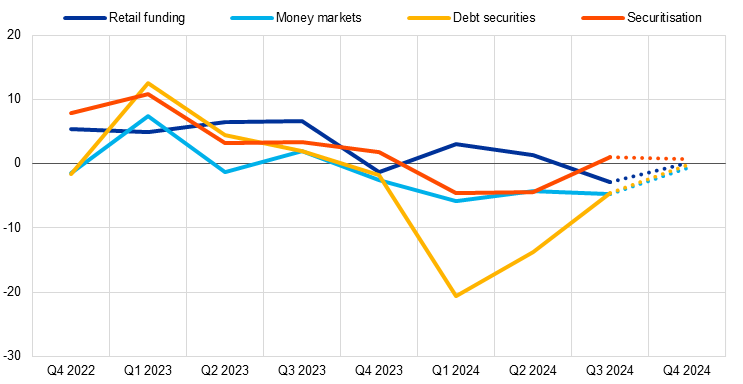
Notes: The net percentages are defined as the difference between the sum of the percentages of banks responding “deteriorated considerably” and “deteriorated somewhat” and the sum of the percentages of banks responding “eased somewhat” and “eased considerably”. “Retail funding” is the unweighted average of “short-term deposits (up to one year)” and “long-term deposits (more than one year)” and other retail funding instruments; “Money markets” refers to the interbank unsecured money market and is the unweighted average of “very short-term money market (up to one week)” and “short-term money market (more than one week)”; “Wholesale debt securities” is the unweighted average of “short-term debt securities (e.g. certificates of deposit or commercial paper)” and “medium to long-term debt securities (incl. covered bonds)”; and “Securitisation” is the unweighted average of “securitisation of corporate loans”, “securitisation of loans for house purchase” and “ability to transfer credit risk off balance sheet”. The last period denotes expectations indicated by banks in the current round.
Table 13
Changes in banks’ access to retail and wholesale funding
(net percentages of banks reporting a deterioration in access)
Retail funding |
Money markets |
Wholesale debt securities |
Securiti-sation |
|||||
|---|---|---|---|---|---|---|---|---|
Total |
Short-term |
Long-term |
Total |
Short-term |
Medium to long-term |
|||
Q2 2024 |
1 |
3 |
0 |
-4 |
-14 |
-10 |
-18 |
-4 |
Q3 2024 |
-3 |
-4 |
-1 |
-5 |
-5 |
-3 |
-6 |
1 |
Q4 2024 |
0 |
0 |
0 |
-1 |
0 |
2 |
-3 |
1 |
Note: See the notes to Chart 15. The last period denotes expectations indicated by banks in the current round.
5.2 Slight pressure on market financing and contained impact on lending from the reduction in the ECB’s monetary policy asset portfolio[15]
The reduction in the ECB’s monetary policy asset portfolio had a slightly negative impact on euro area banks’ market financing conditions over the last six months (-3%; see Chart 16 and Table 14). This reflects the tightening impact of the reduction in the ECB’s monetary policy asset portfolio, mainly related to redemptions of the Eurosystem’s euro area sovereign bond holdings under the ECB’s asset purchase programme (APP). Banks reported also a slight negative impact on banks’ total assets, in line with the small negative impact on lending in some loan categories (see below). The net percentages for the impact on market financing conditions and total assets were the smallest since the start of the reduction of the ECB’s monetary policy asset portfolio in March 2023. At the same time, banks reported a moderate positive impact on their profitability via net interest income.
Chart 16
Overview of the impact of the ECB’s monetary policy asset portfolio on euro area banks’ financial situation
(net percentages of banks reporting an increase/improvement)
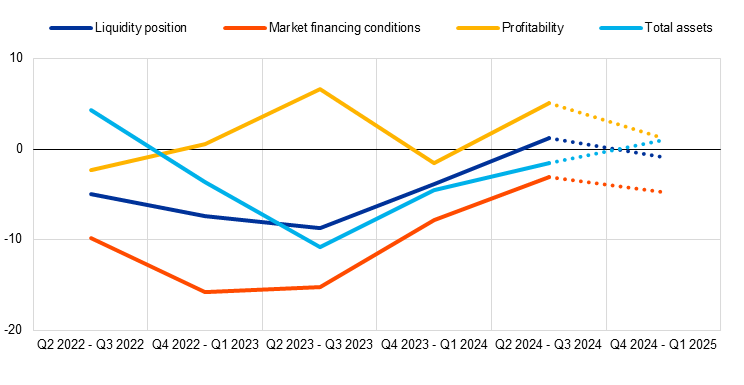
Notes: The net percentages are defined as the difference between the sum of the percentages for “increased/improved considerably” and “increased/improved somewhat” and the sum of the percentages for “decreased/deteriorated somewhat” and “decreased/deteriorated considerably”. The last period denotes expectations indicated by banks in the current round.
Over the next six months euro area banks expect a further moderate negative impact from the ECB’s monetary policy asset portfolio reduction on their market financing conditions. The impact on banks’ total assets and liquidity position is expected to be broadly neutral. Banks also expect a moderate positive impact on net interest income. This is consistent with their expectation that the reduction of the Eurosystem’s sovereign bond holdings will lead to somewhat higher holdings by banks (net percentage of 5%).
Table 14
Impact of the ECB’s monetary policy asset portfolio on banks’ financial situation
(net percentages of banks reporting an increase or improvement)
Total assets |
Liquidity position |
Market financing conditions |
Profitability |
|||
|---|---|---|---|---|---|---|
Total |
Owing to: net interest income |
Owing to: capital gains/losses |
||||
Q4 2023 – Q1 2024 |
-5 |
-4 |
-8 |
-2 |
-1 |
-1 |
Q2 2024 – Q3 2024 |
-2 |
1 |
-3 |
5 |
5 |
-1 |
Q4 2024 – Q1 2025 |
1 |
-1 |
-5 |
1 |
4 |
-2 |
Note: See the notes to Chart 16. The last period denotes expectations indicated by banks in the current round.
Over the past six months euro area banks reported an overall contained impact from the ECB’s monetary policy asset portfolio reduction on their lending conditions, with the exception of credit standards for housing loans (see Chart 17 and Table 15). They reported a neutral impact on their credit standards for loans to firms and a broadly neutral impact on consumer credit, while there was a moderate net tightening impact on credit standards for housing loans. In addition, the impact on banks’ overall terms and conditions was zero across loan categories. Euro area banks also reported a small negative impact on lending volumes to households and a broadly neutral impact on lending to firms (see Chart 18). Overall, the impact of the reduction of the ECB’s monetary policy asset portfolio over the past six months appears limited, reflecting the gradual and predictable adjustment of the portfolio.
Over the next six months banks expect that the reduction in the ECB’s monetary policy asset portfolio will have broadly no further tightening impact on lending conditions and a small dampening impact on lending volumes across loan categories.
Chart 17
Impact of the ECB’s monetary policy asset portfolio on bank lending
(net percentages of banks reporting a tightening or increase)
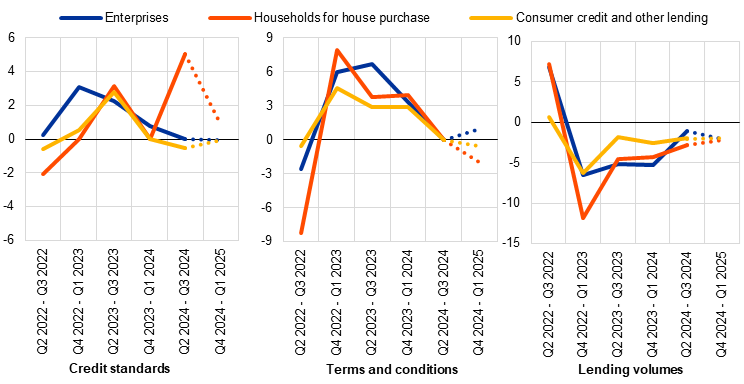
Notes: The net percentages are defined as the difference between the sum of the percentages for “tightened/increased considerably” and “tightened/increased somewhat” and the sum of the percentages for “eased/decreased somewhat” and “eased/decreased considerably”. The last period denotes expectations indicated by banks in the current round.
Table 15
Impact of the ECB’s monetary policy asset portfolio on banks’ credit standards, terms and conditions and lending volumes
(net percentages of banks reporting a tightening/an increase)
Credit standards |
Terms and conditions |
Lending volumes |
|||||||
|---|---|---|---|---|---|---|---|---|---|
Q4 23 – Q1 24 |
Q2 24 – Q3 24 |
Q4 24 – Q1 25 |
Q4 23 – Q1 24 |
Q2 24 – Q3 24 |
Q4 24 – Q1 25 |
Q4 23 – Q1 24 |
Q2 24 – Q3 24 |
Q4 24 – Q1 25 |
|
Loans to enterprises |
1 |
0 |
0 |
3 |
0 |
1 |
-5 |
-1 |
-2 |
Loans to households for house purchase |
0 |
5 |
1 |
4 |
0 |
-2 |
-4 |
-3 |
-2 |
Consumer credit and other lending to households |
0 |
-1 |
0 |
3 |
0 |
-1 |
-3 |
-2 |
-2 |
Note: See the notes to Chart 17. The last period denotes expectations indicated by banks in the current round.
5.3 Neutral impact on banks' lending conditions from the phase-out of TLTRO III[16]
Banks continued to indicate a moderate negative impact on their overall liquidity position from the phase-out of TLTRO III over the past six months (net percentage of -6%; see Chart 18 and Table 16). Maturing TLTRO III funds and early voluntary repayments continued to have a moderate negative impact on banks’ liquidity positions. Given the very significant repayments made between November 2022 and December 2023 and the comparatively small remaining outstanding amounts of TLTRO III, the impact on banks’ overall funding conditions, including market financing conditions, and their ability to fulfil regulatory or supervisory requirements was broadly neutral. The impact on profitability was reported to be slightly positive.
As TLTRO repayments will conclude in December 2024, banks expect no significant impact from the phase-out of TLTRO III on their liquidity situation. As repayments come to an end, banks expect TLTRO III to have a broadly neutral impact on their market funding conditions and profitability.
Chart 18
Impact of TLTRO III on banks’ financial situation
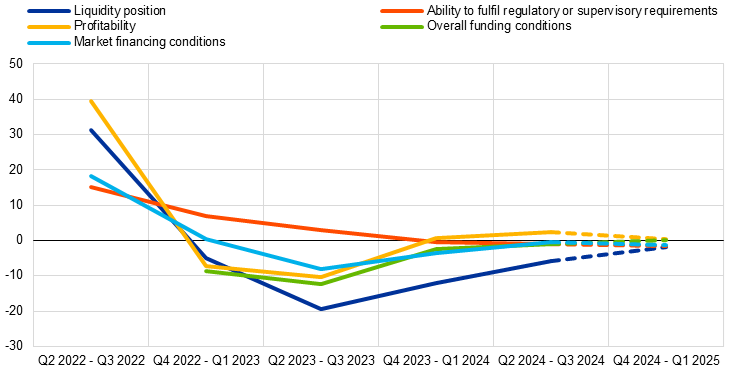
Notes: The signs for these net percentages have been inverted to show net improvements. The net percentages are defined as the difference between the sum of the percentages for “contributed considerably to an improvement” and “contributed somewhat to an improvement” and the sum of the percentages for “contributed somewhat to a deterioration” and “contributed considerably to a deterioration”. “Overall funding conditions” was added in the first quarter of 2023. The last period denotes expectations indicated by banks in the current round.
Table 16
Impact of TLTRO III on banks’ financial situation
(net percentages of banks reporting an improvement)
Liquidity position |
Financing conditions |
Profitability |
Ability to fulfil regulatory or supervisory requirements |
|||
|---|---|---|---|---|---|---|
Overall |
Market financing conditions |
|||||
Q4 2023 – Q1 2024 |
-12 |
-3 |
-4 |
1 |
0 |
|
Q2 2024 – Q3 2024 |
-6 |
-1 |
0 |
2 |
-1 |
|
Q4 2024 – Q1 2025 |
-2 |
0 |
-1 |
0 |
-2 |
|
Note: See the notes to Chart 18. The last period denotes expectations indicated by banks in the current round.
Banks reported a neutral impact from TLTRO III on lending conditions and loan volumes across all lending segments over the last six months, which is expected to continue until the end of the TLTRO III operations (see Chart 19 and Table 17). The neutral impact on credit standards, terms and conditions and lending volumes reflects the smaller outstanding funds and repayments. Over the next six months, euro area banks expect a continued neutral impact from the phase-out of TLTRO III on their lending conditions. They also expect a broadly neutral impact on loan volumes across all categories of lending.
Chart 19
Impact of TLTRO III on bank lending conditions and lending volumes
(net percentages of banks reporting a tightening or increase)
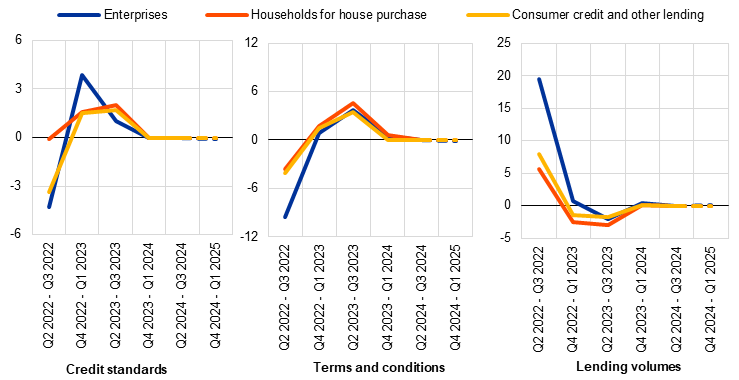
Notes: Net percentages are defined as the difference between the sum of the percentages for “contributed considerably to a tightening or increase” and “contributed somewhat to a tightening or increase” and the sum of the percentages for “contributed somewhat to an easing or decrease” and “contributed considerably to an easing or decrease”. The last period denotes expectations indicated by banks in the current round.
Table 17
Impact of TLTRO III on banks’ credit standards, terms and conditions and lending volumes
(net percentages of banks reporting a tightening/an increase)
Credit standards |
Terms and conditions |
Lending volumes |
|||||||
|---|---|---|---|---|---|---|---|---|---|
Q4 23 – Q1 24 |
Q2 24 – Q3 24 |
Q4 24 – Q1 25 |
Q4 23 – Q1 24 |
Q2 24 – Q3 24 |
Q4 24 – Q1 25 |
Q4 23 – Q1 24 |
Q2 24 – Q3 24 |
Q4 24 – Q1 25 |
|
Loans to enterprises |
0 |
0 |
0 |
1 |
0 |
0 |
0 |
0 |
0 |
Loans to households for house purchase |
0 |
0 |
0 |
1 |
0 |
0 |
0 |
0 |
0 |
Consumer credit and other lending to households |
0 |
0 |
0 |
0 |
0 |
0 |
0 |
0 |
0 |
Note: See the notes to Chart 19. The last period denotes expectations indicated by banks in the current round.
5.4 Impact of ECB interest rate decisions on bank interest margins turned negative; impact on volumes remained negative[17]
Euro area banks reported the first negative impact from ECB interest rate decisions on their net interest margins over the past six months since the end of 2022 (net percentage of -11%, see Chart 20 and Table 18); the impact via volumes of interest-bearing assets and liabilities remained negative (-9%). Having reported substantial positive effects on net interest income and profitability more broadly over the tightening cycle, they signalled a negative impact for the first time over the past six months (a period which includes the ECB rate cuts in June and September), driven by the now negative impact from interest rate margins and a persistently negative impact from volumes.[18] Banks report a small positive impact on non-interest income, driven by higher net fee and commission income. Rate decisions were reported to have a small negative impact on provisioning needs and impairments.
Chart 20
Impact of the ECB’s interest rate decisions on euro area bank profitability
(net percentages of banks; over the past six months and the next six months)

Notes: The net percentages refer to the difference between the sum of the percentages of banks responding “increased considerably” and “increased somewhat” and the sum of the percentages of banks responding “decreased somewhat” and “decreased considerably". The last period denotes expectations indicated by banks in the current round.
Chart 21
Impact of the ECB’s interest rate decisions on net interest income and non-interest income
(net percentages of banks; over the past six months and the next six months)
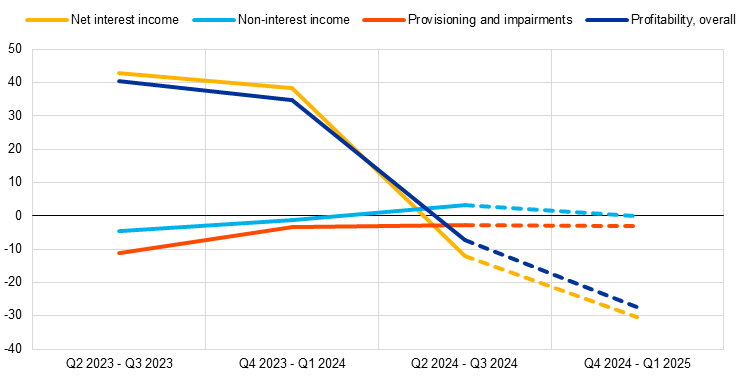
Notes: The net percentages refer to the difference between the sum of the percentages of banks responding “increased considerably” and “increased somewhat” and the sum of the percentages of banks responding “decreased somewhat” and “decreased considerably". Net percentages are inverted in the case of provisioning and impairments. The last period denotes expectations indicated by banks in the current round.
Euro area banks expect the net impact of past and expected ECB interest rate decisions on margins and bank profitability to become more negative over the next six months (net percentages of -33% and -27% respectively; see Charts 20 and 21 and Table 18), while the impact on loan volumes is expected to turn positive (8%).[19] The expected negative impact on profitability is driven by a further negative impact on net interest income, via compressed margins. However, banks expect rate decisions to moderately support loan volumes over the next six months. The impact on provisioning and impairments is expected to remain slightly negative, while non-interest income is expected to remain unchanged, with a moderately positive impact on net fee and commission income outweighed by small capital losses.
Table 18
Impact of ECB interest rate decisions on bank profitability
(net percentages of banks reporting an increase)
Q4 2023 – Q1 2024 |
Q2 2024 – Q3 2024 |
Q4 2024 – Q1 2025 |
|
|---|---|---|---|
Profitability |
35 |
-7 |
-27 |
Net interest income |
38 |
-12 |
-30 |
Owing to: margin effect |
40 |
-11 |
-33 |
Owing to: volume effect |
-21 |
-9 |
8 |
Non-interest income |
-1 |
3 |
0 |
Owing to: capital gains/losses |
-1 |
0 |
-2 |
Owing to: net fee and commission income |
1 |
3 |
4 |
Provisioning and impairments |
-3 |
-3 |
-3 |
Notes: See the notes to Charts 20 and 21. The last period denotes expectations indicated by banks in the current round.
See more.
© European Central Bank, 2024
Postal address 60640 Frankfurt am Main, Germany
Telephone +49 69 1344 0
Website www.ecb.europa.eu
All rights reserved. Reproduction for educational and non-commercial purposes is permitted provided that the source is acknowledged.
For specific terminology please refer to the ECB glossary (available in English only).
PDF ISSN 1830-5989, QB-BA-24-003-EN-N
HTML ISSN 1830-5989, QB-BA-24-003-EN-Q
